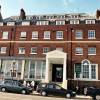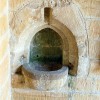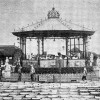Saviour of Forde Abbey
In the century following the dissolution of the monasteries Forde Abbey was the property of distant owners. For decades the building was neglected and allowed to deteriorate; the Abbey Church was lost and four centuries of improvements by the monks disappeared along with much of the stone and fabric, which was looted.
In 1649 Sir Henry Rosewell sold the Abbey and estate to Edmund Prideaux, Member of Parliament for Lyme Regis, a seat he held until his death. Prideaux took his degree as Master of Arts at Cambridge University. His chief field of study was the law, something he was later to become very eminent in. He was a member of the Long Parliament and was Solicitor-General in 1648. A member of the prevailing party of the day, he did not join his colleagues in attacking the life of the Sovereign and he avoided taking any part in the King’s trial.
In 1649 he was appointed Attorney-General to the Lord Protector and remained in that office until his death. He was a commissioner of the Great Seal and practised within the Bar as King’s Counsel. Prideaux was a very wealthy individual, as besides his lucrative legal practice from 1644 to 1653 he gained great profit from his involvement with the postal service. Oliver Cromwell made Prideaux a Baronet on the 13th of August 1658; the Lord Protector died three weeks later, on the 3rd of September 1658.
Perhaps because it was the property of Mr Attorney-General Prideaux, Forde Abbey was saved from the vandalism suffered by many country mansions during the Civil Wars. Having bought Forde Abbey he spent enormous sums of money improving it. He employed the services of Inigo Jones, who was at that time attempting to introduce the Grecian style of architecture into this country. He did not live to see his designs for Forde Abbey completed, for he died in 1654, whilst work on the house was not finished until 1658.
Edmund Prideaux was born in September 1601 at Netherton, Devon. He was the second surviving son of Sir Edmund Prideaux (1555-1629), being descended from an old family originally from Prideaux Castle in Cornwall. Edmund Prideaux’s first wife was Jane Collins and shortly after her death in 1629 he married Margaret Ivery of Cothay in Somerset. He died on the 8th of August 1659 and was succeeded by his only son, also Edmund, who had married Amy Fraunceis of Combe Florey in Somerset in 1655 (Cromwell’s titles were not accepted after the restoration.)
The Price of a Life: Innocent or Guilty
Edmund Prideaux was a well-educated man; for some time his teacher was Bishop Tillotson, later Archbishop of Canterbury. Edmund’s contemporaries referred to him as “the walking encyclopaedia.”
In view of the high profile his father had during Cromwell’s rule, we should not be surprised there was no place for him in government after the restoration. He appears to have lived quietly at Ford Abbey.
Towards the end of 1680 the Duke of Monmouth visited Forde Abbey during a tour of the West Country, where he was treated by Edmund Prideaux to a very splendid supper and given a bed for the night. This hospitality was to return to haunt Edmund, cost him great expense and nearly his life.
In 1681 Edmund Prideaux was elected one of the Members of Parliament for Taunton. We learn from a note in his own handwriting that on the 16th of July 1683 his home was searched for arms. Two muskets, one brass blunderbuss and four cases of pistols were removed.
The year of 1685 was memorable, particularly in the West Country after Monmouth landed at Lyme Regis. Edmund Prideaux, it is said, remained at Forde Abbey. News reached London that during this time Prideaux received a visit at night from a group of eight men led by Thomas Dare of Taunton; they were given horses and arms. Furthermore it was reported that one of the party, Malachi Mallock, drank the health of Monmouth.
Mallock was later arrested and appeared before Judge Jeffreys at Dorchester on September 10th and was condemned to death and should have been hanged at Bridport on September 12th. Mallock bargained for his life by offering to give evidence that would implicate Edmund Prideaux in the Rebellion.
We know from a private pocket-book kept by Edmund Prideaux that on the 19th of June 1685 he was taken prisoner by a messenger, Mr Sayell; the entertainment of Monmouth in 1680 had caught up with him. He was released by Habeas Corpus on the 12th of July, only to be arrested again on September 14th following Mallock’s evidence against him, and transferred to the Tower.
Judge Jeffreys was of the opinion that some Royalists had been ruined by the Rebellion and should be compensated from sums raised by the sale of prisoners, something Jeffrey’s did not engage in himself, with one exception: Edmund Prideaux.
Prideaux was in custody and instead of being brought to trial he was given to Jeffreys to agree his own terms with the prisoner, who had not been charged with any offence. Jeffreys insisted on a huge bribe to obtain a pardon, which was granted on the 20th of March 1686. Jeffreys used the £15,000 he got from Prideaux as part of the price he paid for his Leicester estates.
After the accession of William III, Edmund Prideaux presented a petition to Parliament for leave to bring a Bill to charge the estates of Lord Chancellor Jefferys with the restitution of the £15,000 he paid for his pardon. Following fierce opposition from Lord Chief Justice Pollexfen, trustee for the children and creditors of Jeffreys, the Bill was not carried.
His fortune greatly diminished, Edmund Prideaux lived out his days peacefully at Forde Abbey. His only son, Fraunceis Prideaux, died at Oxford aged 19. He had three daughters: Amy, who died at a young age; Elizabeth, who was married to John Speke of Somerset, and Margaret, who was married in 1690 to her cousin, Francis Gwyn of Glamorgan in Wales.
Edmund Prideaux died intestate on October 16th 1702 and, his wife having renounced, letters of administration were granted to Margaret Gwyn, his sole surviving daughter and heiress.



